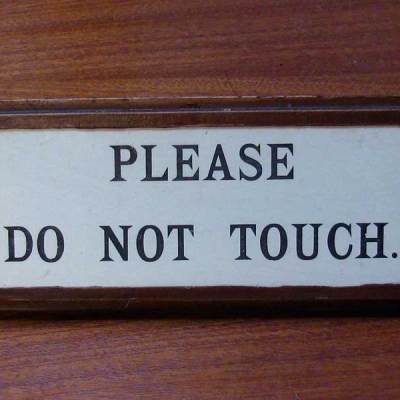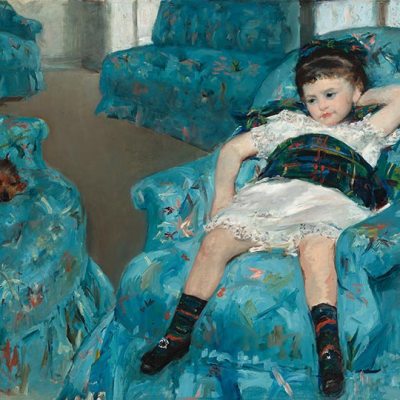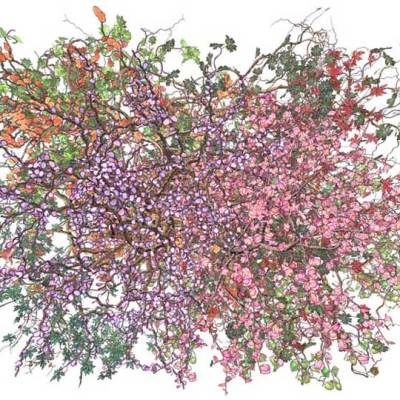The gallery appears to be empty. Peres Projects, on Karl-Marx-Allee (formerly Stalin Allee), is on the ground floor of a wedding-cake style luxury apartment building, built during the East German reconstruction programme after the Second World War. The walls facing the wide boulevard are bare. Two freestanding walls run floor-to-ceiling, perpendicular to the windows that line the gallery.
Only upon closer inspection do these objects reveal themselves as paintings. Four, in fact, are hung back-to-back, and sway gently, unattached to the ground. Only millimetres are left to spare between the ceiling and the floor for the ultra-thin ‘frame’, which is nail-gunned, in one-metre lengths, into the edges of the stretchers. Despite their size – towering four meters high – they are incredibly shallow, only the depth of an easel-sized canvas.
They are nearly blank. A piece of raw linen is wheat-pasted haphazardly onto one. A subtle gesture of spray-paint, and a woman’s footprints a la Johns and Klein, mark another. They divide the gallery into three areas of varying size, in line with the pre-existing architecture.
The sparest painting – a primed canvas that has been sewn to a slender vertical length of unprimed canvas (perhaps a nod to a technique of widening the painting, famously used by Matisse, among others) – stands before a vast empty space that dwarfs other galleries in Berlin. Meanwhile, the densest painting – an all-black monochrome jizzed with white paint splatters – faces the back wall, forcing the viewer up close to the canvas. The architectural spaces that the paintings create transform their reading drastically. It is impossible to see more than one painting at a time.
Installation view: David Ostrowski, ‘Emotional Paintings’ (2014) at Peres Projects, Berlin. Pictured: F (The best part of the story) (2014) Photo by the author for Apollo

There is no room in this body of work for hand-wringing about what constitutes a finished painting. There is a strong art-historical precedent for it, particularly in Germany. Consider Michael Krebber’s barely-there paintings from the early 2000s, which pushed de-skilling, a common trope in painting from the beginning of the 20th century, to its most extenuated point. But unlike Krebber, these paintings do not register as a critique of painting, or the market. Ostrowski pushes the point even further.
Owstrowski’s gestures – the touch of spray paint, the woman’s footprint – are studied, and intentional. They are not failures, but rather, cultivate the appearance of failure. They are calculated outcomes, and the real work of them begins during their presentation. Ostrowski insists that he is a ‘romantic’ painter – the show is titled ‘Emotional Paintings’ – rather than a cynical critic. But here, all of the emotion is drained out of the works. They are not minimal, which would at least be something, like a Robert Ryman perhaps. But no, these are emphatically nothing.
The installation is dependent on the architecture of the gallery, which is loaded with political significance from the 20th century; indeed, built as luxury apartments for the proletariat, these socialist classicist buildings remain the ultimate image of Soviet power and influence in Germany. These paintings gesture to high modernist abstraction, the contemporaneous art-historical moment. Combining these two opposites (socialist architecture vs. capitalist painting) foregrounds Ostrowski’s apolitical stance.
‘David Ostrowski: Emotional Paintings’ is at Peres Projects, Berlin, until 21 June.



